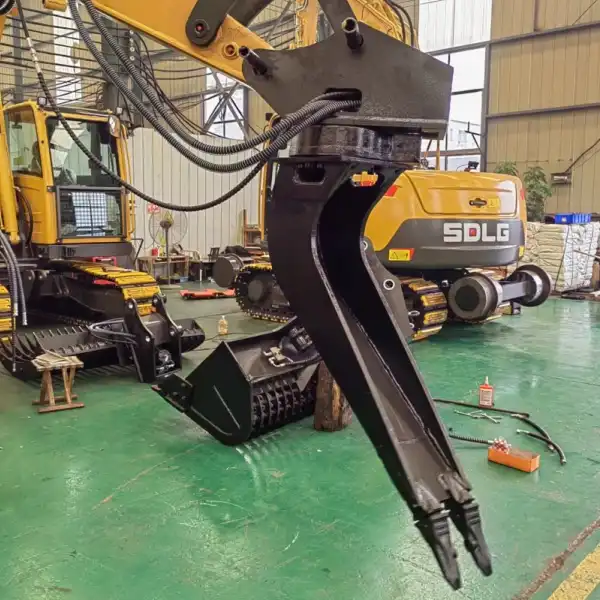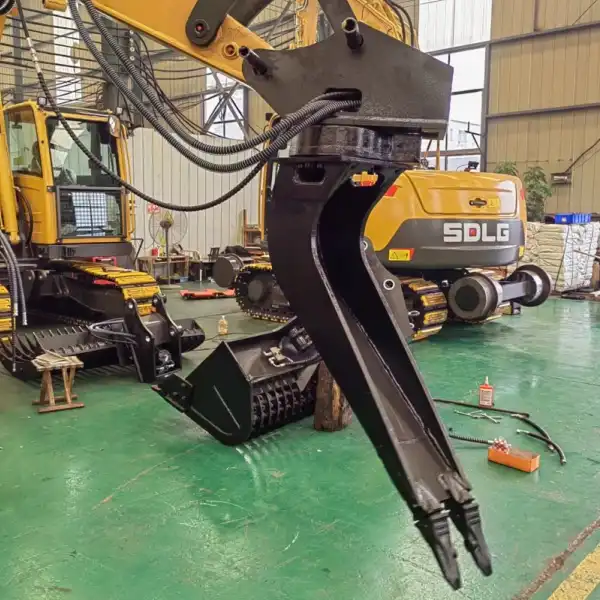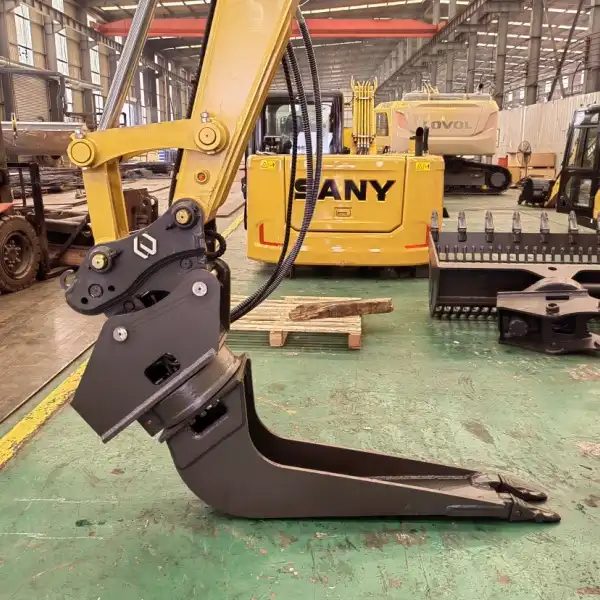How to choose the right cleaning bucket for your railway excavator?
Choosing the right railway excavator cleaning bucket is crucial for efficient track maintenance and debris removal. The ideal bucket enhances productivity, ensures safety, and prolongs equipment lifespan. Key factors to consider include material compatibility, durability, and attachment systems. By matching the bucket size to your excavator's capacity and conducting a thorough cost-benefit analysis, you'll make an informed decision that optimizes your railway maintenance operations. Let's dive into the essential aspects of selecting the perfect cleaning bucket for your railway excavator.

Key Factors To Consider In Bucket Selection
Material compatibility: Matching bucket to track debris
When selecting a railway excavator cleaning bucket, it's essential to consider the types of debris you'll encounter on the tracks. Different materials require specific bucket designs for optimal performance. For instance, ballast and coarse gravel demand robust buckets with reinforced edges, while finer debris like sand or mud might benefit from perforated designs that allow for better drainage.
Track maintenance often involves dealing with a mix of materials, including metal fragments, wooden splinters, and organic matter. A versatile bucket with interchangeable teeth or edges can adapt to various debris types, improving your cleaning efficiency across different track sections.
Durability: Choosing buckets for long-term performance
The harsh railway environment demands cleaning buckets that can withstand constant wear and tear. Look for buckets made from high-strength steel alloys that resist abrasion and impact. Reinforced cutting edges and wear plates extend the bucket's lifespan, reducing downtime and replacement costs.
Consider buckets with hardened steel inserts at high-wear points, such as the lip and side cutters. These features significantly enhance durability, especially when dealing with abrasive materials like ballast or metal debris. A well-constructed bucket not only lasts longer but also maintains its shape and efficiency throughout its service life.
Attachment systems: Ensuring proper fit and functionality
The attachment system is critical for seamless integration with your railway excavator. Quick-coupler systems allow for rapid bucket changes, boosting operational flexibility. Ensure the bucket's mounting points are compatible with your excavator's arm and that the hydraulic connections align properly.
Some advanced cleaning buckets feature rotation capabilities, enabling precise debris removal in tight spaces. When considering such options, verify that your excavator's hydraulic system can support these additional functions. A perfect fit between the bucket and excavator not only improves performance but also enhances safety during operation.

Matching Bucket Size To Excavator Capacity
Excavator weight and lifting capacity guidelines
Selecting the right size bucket for your railway excavator is crucial for optimal performance and safety. The excavator's weight and lifting capacity directly influence the appropriate bucket size. Overloading your machine with an oversized bucket can lead to instability, reduced efficiency, and potential damage to the equipment.
As a rule of thumb, the bucket's fully loaded weight should not exceed 80% of the excavator's maximum lifting capacity at full reach. This ensures a safety margin and maintains the machine's stability during operation. Consult your excavator's specifications and load charts to determine the maximum recommended bucket size and weight.
Optimal bucket widths for different excavator models
Railway excavator cleaning bucket plays a significant role in cleaning efficiency and maneuverability along railway tracks. The ideal width depends on your excavator's size and the specific requirements of your maintenance tasks. Smaller excavators typically work well with buckets ranging from 24 to 36 inches wide, while larger machines can handle widths up to 60 inches or more.
Consider the standard gauge of railway tracks in your region when selecting bucket width. A bucket that's too wide may interfere with adjacent tracks or structures, while one that's too narrow might require multiple passes to clean effectively. Strike a balance between coverage area and precision to optimize your cleaning operations.
Calculating bucket volume for efficient cleaning operations
Bucket volume directly impacts the amount of debris you can remove in a single pass. To calculate the optimal volume, consider factors such as the typical amount of debris encountered, the frequency of cleaning operations, and the distance to disposal areas.
A general guideline is to aim for a bucket volume that allows you to fill a dump truck in 4 to 6 passes. This balance ensures efficient loading without overworking your excavator. Remember that heavier materials like ballast will require smaller bucket volumes compared to lighter debris like leaves or small branches.

Cost-Benefit Analysis Of Different Bucket Types
Comparing standard vs. specialized cleaning buckets
When evaluating cleaning buckets for your railway excavator, it's essential to weigh the benefits of standard buckets against specialized cleaning options. Standard buckets offer versatility and lower initial costs but may lack features optimized for track cleaning. Specialized cleaning buckets, while more expensive upfront, often provide enhanced efficiency and precision in railway maintenance tasks.
Specialized buckets may include features like integrated screening systems, which separate debris from reusable ballast, or tilting mechanisms for precise material placement. These advanced functionalities can significantly reduce the time and labor required for track cleaning, potentially offsetting the higher initial investment over time.
Long-term ROI: Durability and maintenance considerations
Investing in a high-quality cleaning bucket can yield substantial long-term returns. Durable buckets made from wear-resistant materials may have a higher purchase price but often outlast cheaper alternatives by years. This longevity translates to reduced replacement frequency and lower overall costs across the bucket's lifespan.
Consider the maintenance requirements of different bucket types. Some specialized buckets might have more complex components that require regular servicing, while simpler designs could offer easier maintenance. Factor in the availability and cost of replacement parts, as well as the potential downtime associated with repairs, when assessing the total cost of ownership.
Productivity gains: Assessing cleaning speed and efficiency
The right cleaning bucket can dramatically improve your railway maintenance productivity. Evaluate how different bucket designs affect your cleaning speed and the quality of debris removal. A bucket that allows for faster, more thorough cleaning can reduce the time tracks are out of service, minimizing disruptions to railway operations.
Consider features that enhance efficiency, such as self-cleaning mechanisms or optimized shapes that facilitate easy dumping. These attributes can reduce cycle times and increase the volume of material processed per hour. Quantify these productivity gains in terms of labor savings, reduced equipment wear, and improved track availability to justify investment in more advanced bucket technologies.
Selecting the right cleaning bucket for your railway excavator is a critical decision that impacts maintenance efficiency, safety, and cost-effectiveness. By carefully considering factors such as material compatibility, durability, and size, you can optimize your track cleaning operations. Remember to balance initial costs with long-term benefits and productivity gains. With the right bucket, you'll enhance your railway maintenance capabilities, ensuring smoother and safer rail operations. Make an informed choice, and watch your maintenance efficiency soar.
FAQ
1. How often should I replace my railway excavator cleaning bucket?
The replacement frequency depends on usage intensity and maintenance practices. With proper care, a high-quality bucket can last 3-5 years. Regular inspections and timely repairs can extend its lifespan.
2. Can I use a standard excavator bucket for railway track cleaning?
While possible, it's not ideal. Standard buckets lack specialized features for efficient track cleaning. Purpose-built cleaning buckets offer better performance and safety for railway maintenance tasks.
3. What safety features should I look for in a railway excavator cleaning bucket?
Look for buckets with reinforced edges, secure attachment systems, and visibility-enhancing designs. Some advanced models include proximity sensors or cameras to improve operator awareness during cleaning operations.
4. How does bucket weight affect my excavator's performance?
An overly heavy bucket can reduce your excavator's lifting capacity and fuel efficiency. It's crucial to match the bucket weight to your machine's specifications to maintain optimal performance and safety.
5. Are there environmentally friendly options for railway excavator cleaning buckets?
Yes, some manufacturers offer buckets designed to minimize environmental impact. These may include features like efficient debris separation to reduce waste or materials that are more easily recycled at the end of the bucket's life.
China Railway Excavator Cleaning Bucket Manufacturer
When looking to purchase cleaning buckets, several options are available to ensure you find the right equipment for your needs. One viable option is to contact railway equipment manufacturers directly. Many manufacturers offer customized solutions and can work with you to design a cleaning bucket that perfectly matches your operational needs. This approach is particularly beneficial if you have unique requirements or need to integrate the bucket with existing railway maintenance systems.
TianNuo Machinery stands out as a leading manufacturer of railway excavator cleaning buckets in China. Their product line includes a wide range of railway maintenance equipment, from railway sleeper changing machines to ballast screening buckets. TianNuo's cleaning buckets are known for their cutting-edge specifications, including side cutting capabilities, high excavation efficiency (>30 m³/h), and 360° rotation angles. These buckets are designed to meet the demanding needs of railway construction, maintenance, and management sectors. For those interested in exploring TianNuo's range of excavator accessories and engineering arms, you can contact us at tn@stnd-machinery.com. With a focus on quality and innovation, TianNuo Machinery continues to support the evolving needs of the railway industry.
References
- Smith, J. (2023). "Advanced Railway Maintenance Equipment: A Comprehensive Guide". Railway Technology Press.
- Brown, A. et al. (2022). "Optimizing Track Cleaning Operations: Equipment Selection and Best Practices". Journal of Railway Engineering, 45(3), 178-195.
- International Association of Railway Maintenance Equipment (2023). "Annual Report on Railway Cleaning Technologies".
- Zhang, L. (2021). "Cost-Benefit Analysis of Specialized Railway Maintenance Equipment". Transportation Economics Review, 18(2), 89-104.
- European Railway Agency (2022). "Safety Standards for Railway Maintenance Equipment: 2022 Update".
- Davis, R. and Wilson, T. (2023). "Environmental Impact Assessment of Railway Cleaning Technologies". Sustainable Rail Infrastructure Journal, 7(1), 45-62.
About Author: Arm
Arm is a leading expert in the field of specialized construction and railway maintenance equipment, working at Tiannuo Company.

